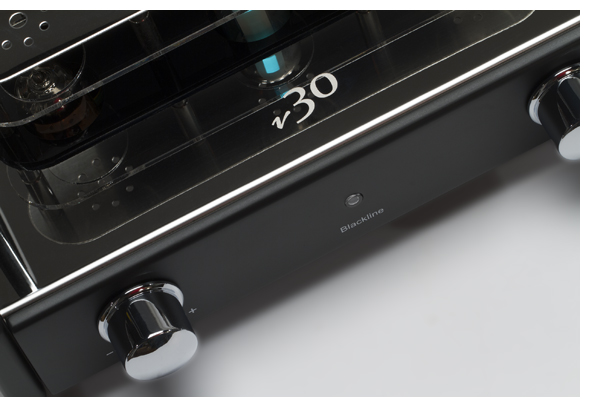 With the burgeoning number of adults working from home, the office-audio category has become an industry bright spot. Filling this space is Blue Aura’s $549 v30 Blackline music system, which satisfies the craving for vacuum tubes and matching speakers, and does so in a space-conscious package.
With the burgeoning number of adults working from home, the office-audio category has become an industry bright spot. Filling this space is Blue Aura’s $549 v30 Blackline music system, which satisfies the craving for vacuum tubes and matching speakers, and does so in a space-conscious package.
The handsome, three-piece system looks sharp wherever I place it in my office—I tried both my bookshelf and credenza—but the system’s striking aesthetics never dominate the décor. Los Angeles–based Blue Aura wraps the speakers and the body of the amp in black faux-leather, and accents the amp with chrome trimmings.
The amp is 10 inches wide, 7.5 inches deep and 5.5 inches tall, and the plated handles on either side of it double nicely as bookends. Adorning the front panel is a pair of matching chrome knobs—one for adjusting the volume and one for selecting from the three inputs (USB, LINE, and AUX). Two 6N1 tubes flank the taller 6e2 tube, with its decorative but unnecessary green glowing light filter. A four-post tube guard with a plexiglass-and-chrome top shelf protects the tubes from inadvertent fingers or the common office mishap. On the back panel, from left to right, are three inputs (RCA, mini-headphone, and mini-USB B), followed by a mini-headphone output jack, four brass speaker jacks, the power-cord socket and power switch.
The 5.5-inch tall speakers look similar to the Audioengine A2s, with forward-facing slits towards the bottom of each speaker serving as bass ports. The 3/4-inch tweeter and 3.5-inch paper driver surprised me from the outset with some obvious low-frequency grunt and detail. With the speakers set on their over-sized-hockey-puck stands and with the bookcase as an additional cabinet, the sexy, sultry vocals of Sade fill my 11-by-10-foot office. Changing out the included 18-gauge speaker wire for some 12-gauge wire further defineds the speaker’s impressive resolution.
Forget the typical tinny computer sound and irritating fake subwoofer output—the v30 avoids that pitfall. This is a setup I find enjoyable listening to for several hours, which helps me grade papers without becoming restless. When playing rounded sharp-edged recordings, such as Donald Fagan’s Kamakiriad, the v30 settles down nicely. I then play some lossless recordings, with my laptop and Audioengine D2 wireless DAC system on my desk and the v30 on the bookcase, and intoxicating sound fills the office. Even with the speakers just 30 inches apart, the system offers impressive instrument placement.
It’s obvious that the Blue Aura engineers understood that the typical home-office setup limits how far apart speakers can be placed. The result is a nice, expansive soundstage and subsequent enjoyable listening experience. Even stepping down to my MacBook’s analog output and running a wire to the v30 yields worthwhile results.
The system excels at reproducing jazz music, and quickly makes Vince Guaraldi’s classic Charlie Brown Christmas a playlist favorite. The v30’s ability to recreate the individual bass notes in “O Tannenbaum” bests the budget bookshelf speakers that normally occupy my office—and those are more than three times the size of the v30’s speakers. Guaraldi’s piano matches the glow that the three tubes adds to the keystrokes. The slight loss in absolute detail is easily made up by the system’s warmth and rich decay.
As the days pass, the v30 becomes the reason to listen to music, the goal being to see what it can handle musically. While blasting Slayer at house-party levels isn’t realistic, the unit has no problem getting into the 90-plus-dB range before hitting its sonic wall. It delivers more complex rock with ease. John Mellencamp’s Lonesome Jubilee, with its multitude of instruments, sounds open and uncongested—a neat trick for such a diminutive setup.
As expected, the v30’s three glowing tubes make the midrange beguiling. Female vocals and instruments are lush and warm, and void of the syrupy slow quality that creeps into many budget tube systems. In this price range, the v30 is downright first-rate, especially in the level of clarity it brings to Pink Martini’s “Mar Desconocido,” with its tempo-leading bongos, and to the plucked guitar and xylophone in the next track, “Taya Tan.”
One Sunday afternoon, I pair the 20-wpc integrated amplifier with the 92-dB-efficient Verity Audio Finns. The v30 does itself proud here, powering the Finns with confidence. Though the amplifier section won’t make one forget PrimaLuna’s resolution, particularly in the higher register, it does move some serious air, representing the basics of tone and balance remarkably well.
Even in larger spaces, such as my 13-by-19-foot family room, the v30 delivers open sound. With the amp and speakers on the rock fireplace hearth with the angled puck speaker stands tilted upward, the room fills with warm holiday sounds. Even with the sliding door to the kitchen closed, I was still able to enjoy the details emanating from the system.
For those that desire tunes but need focus on work in their office, the musicality of the v30 Blackline make it a top-tier choice for the home office. Looking to add a source wirelessly? Just add Blue Aura’s WSTxR wireless transmitter/receiver kit for $149.











